
Thoth (Tehuty, Djehuty, Tahuti, Tehuti, Zehuti, Techu, Tetu) was one of the earliest Egyptian gods. He was popular throughout Egypt, but was particularly venerated in Khnum (Hermopolis Magna) where he was worshipped as part of the Ogdoad.
As the power of his cult grew, the myth was rewritten to make Thoth the creator god. According to this variant, Thoth (in the form of an ibis, one of his sacred animals) laid an egg from which Ra (Atum, Nefertum, or khepri) was born.

Other myths suggest that Thoth created himself through the power of language (in an interesting parallel to the phrase in the Gospel according to St John “in the beginning was the word, and the Word was with God, and the Word was God”). His song was thought to have created eight deities of the Ogdoad (the gods Nun, Heh, Kuk, and Amun and the goddesses Nunet, Hauhet, Kuaket, and Amaunet).
The moon and the sun were initially thought of as the left and right eyes of Horus. According to legend, Horus’ left eye (the moon) was injured in a fight with Set and was restored by Thoth (“the eye of Horus”). However, as time progressed the moon came to be associated with Thoth, possibly because the crescent moon resembled the beak of an Ibis. During the Late period, Thoth gained prominence when Khnum (Hermopolis Magna) became the capital. Archeologists found thousands of mummified ibis who were buried with honour in his name.
Although Osiris and Isis were generally credited with bringing civilisation to mankind, Thoth was also thought to have invented writing, medicine, magic, and the Egyptian’s civil and religious practices. He was even credited with the invention of music, which was more often associated with Hathor.
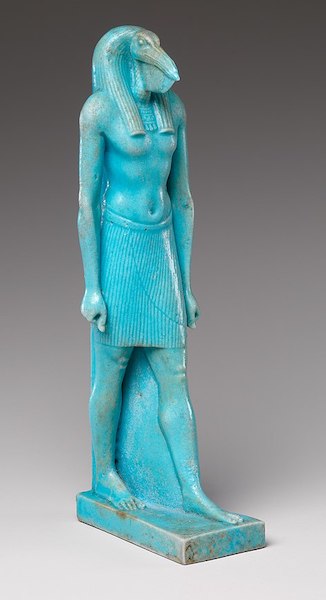


Thoth was the patron of scribes and of the written word. He was scribe of the underworld who recorded the verdict on the deceased in the hall of Ma’at and was given the epithets “He who Balances”, “God of the Equilibrium”, and “Master of the Balance”.
Thoth maintained the library of the gods with the help of his wife, Seshat (the goddess of writing). He was the scribe of the gods, and was often described as the “Lord of the Divine Body”, “Scribe of the Company of the Gods”, the “voice of Ra”, or the “counsellor of Ra” who (along with Ma’at) stood on the sun barge next to Ra on his nightly voyage across the sky.
It was also thought that Ra gave Thoth an area of the underworld to rule in the “Land of the Caves”. He kept a register of those in his realm and decreed just punishments for their transgressions and acted as Ra’s representative in the afterlife. In this role, his wife was Ma’at.
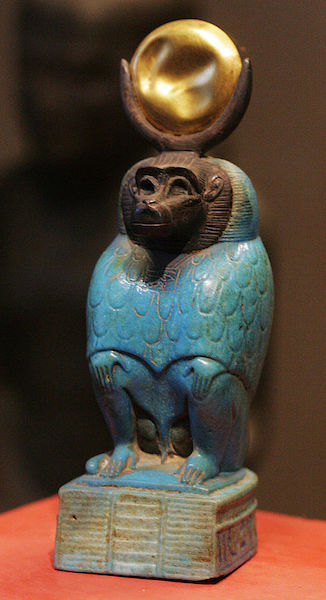
It was said that he was the author of the spells in the “Book of the Dead” and “Book of Breathings” (which was also attributed to Isis) and he was given the grand title, the “Author of Every Work on Every Branch of Knowledge, Both Human and Divine”.
Egyptian mythology speaks of the “Book of Thoth” in which the god inscribed all of the secrets of the universe. Anyone who read it would become the most powerful sorcerer in the world, but would be cursed by their knowledge. Needless to say, people have been searching for this text despite the warning, and some more “colourful” theories propose that it is hidden in a secret chamber in or near the Great Pyramid. This book is said by some to be the “emerald tablets of Thoth” a work of dubious authenticity which suggests that Thoth and the other gods were from Atlantis.
Thoth was a great magician who knew “all that is hidden under the heavenly vault”. He used his knowledge to help Isis after the murder of her husband Osiris by his brother Set. With the help of Anubis he created the first mummification ritual and helped resurrect Osiris (albeit in the land of the Dead). He also protected the son of Isis, Horus, by driving a magical poison from his body when he was very young and supported him in his fight to gain the throne which was rightfully his.
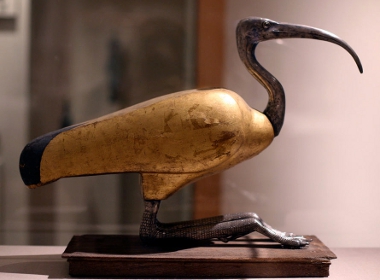
Many of the Egyptian’s religious and civil rituals were organised according to a lunar calendar. As Thoth was associated with writing and with the moon it is perhaps unsurprising that he was also linked to the creation of the calendar. As his association with the moon waned, he developed into a god of wisdom, magic and the measurement of time. Similarly he was considered to measure and record time. He was known by the epithets; “the One who Made Calculations Concerning the Heavens, the Stars and the Earth”, “the Reckoner of Time and of Seasons” and “the one who Measured out the Heavens and Planned the Earth”.
Thoth was thought to be the inventor of the 365-day calendar (which replaced the inaccurate 360 day calendar). According to myth, he earned the extra days by gambling with the moon (Iabet or Khonsu) in a game of dice to help the goddess Nut. She was pregnant by her brother / husband Geb, but Ra forbade her to give birth on any day of the Egyptian calendar. Thoth won a portion of light from the moon (1/72) which equated to five new days, and Nut gave birth to her five children on those days (Osiris, Horus the Elder, Set, Isis, and Nephthys).
Thoth was also known as a good counsellor and persuasive speaker. In one version of an ancient myth Thoth and Shu were sent by Ra to persuade the “eye of Ra” (in this version usually in the form of Tefnut) to come home when she left Egypt for Nubia. According to the myth, all of the precious water left Egypt with her causing the land to become parched and dry. Meanwhile she was rampaging around Nubia killing animals and humans and drinking their blood. Thoth and Shu disguised themselves as baboons (an animal sacred to Thoth) and began their search for the wayward goddess.
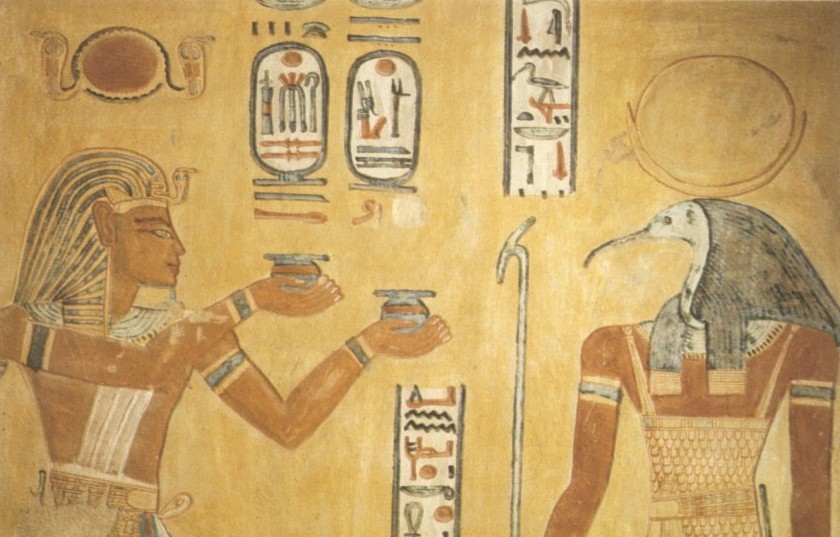
When they found her she refused to come home because she was perfectly happy where she was. Thoth told her that Egypt missed her terribly and that the whole land was suffering in her absence, and he promised her great processions and celebrations if she would come home. Eventually she agreed, won round by his extravagant tales and the three returned to Egypt accompanied by Nubian musicians, dancers, and baboons. They travelled up the Nile from city to city, bringing back the water, and there was much rejoicing.
He was said to be the husband (or sometimes father) of Seshat, an ancient goddess of wisdom. As time passed Thoth gradually absorbed most of Seshat’s roles, and she was seen largely as his female aspect. They had a child called Hornub. At Khnum (Hermopolis) he was the husband of Nehmauit (Nahmauit, Nehmetaway), goddess of protection. Their child was the god Neferhor.
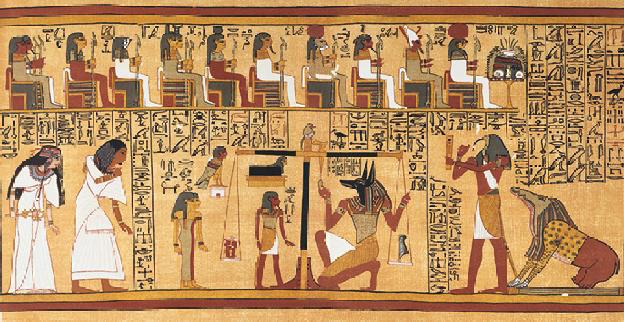
Thoth was also sometimes considered to be the husband of Ma’at. Because he could take the form of a baboon, he was sometimes described as the partner of Astennu (one of the male baboons who lived in the underworld), although it was also stated that Astennu was simply an aspect of Thoth.
Most often depicted as a man with the head of an ibis, Thoth often holds a scribe’s palette and stylus but could also be depicted with an ankh (representing life) and a sceptre (representing power). Thoth sometimes wore a crescent moon on his head, but was also depicted wearing the Atef crown, and the double crown of Upper and Lower Egypt.
When he was acting as the “voice of Ra”, he carried the “Eye of Ra” (a symbol of the power of the sun). Occasionally, Thoth was depicted as an ibis or a baboon. It is thought that the bird was associated with the moon because of its crescent shaped beak, and the baboon is a nocturnal animal which has the peculiar habit of chattering at the sun every day before going to sleep.
The Greeks associated Thoth with the messenger god Hermes. The two deities were combined to form Hermes Trismegistus and Khmun was renamed Hermopolis (“city of Hermes”). This version of Thoth remains popular with occultists today.
Bibliography
- Bard, Kathryn (2008) An introduction to the Archaeology of Ancient Egypt
- Budge, E Wallis (1904) The Gods of the Egyptians
- Goodenough, Simon (1997) Egyptian Mythology
- Kemp, Barry J (1991) Ancient Egypt: Anatomy of a Civilisation
- Pinch, Geraldine (2002) Handbook Egyptian Mythology
- Redford Donald B (2002) Ancient Gods Speak
- Watterson, Barbara (1996) Gods of Ancient Egypt
- Wilkinson, Richard H. (2003) The Complete Gods and Goddesses of Ancient Egypt
- Wilkinson, Richard H. (2000) The Complete Temples of Ancient Egypt
Copyright J Hill 2010